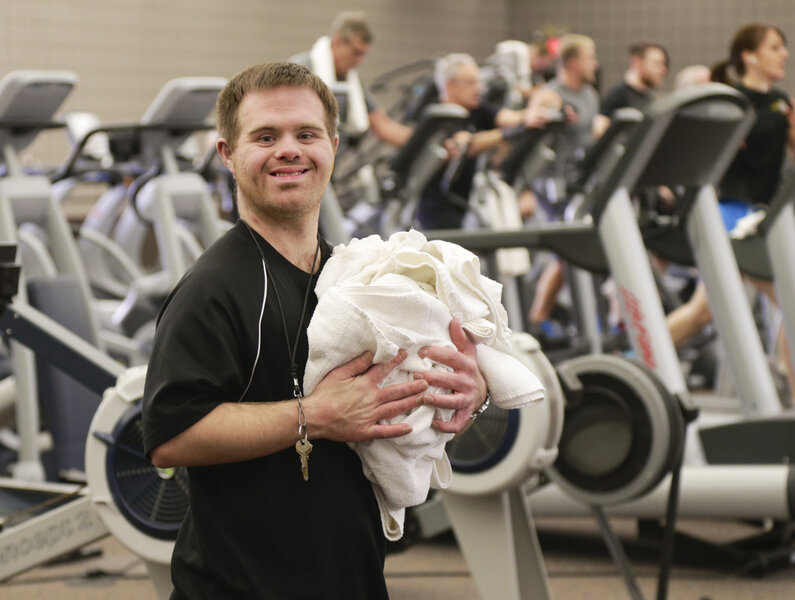Why the number of new jobs for people with disabilities grew fourfold
For years, Donald Minor says, he blamed a disability – a lack of muscle control in his arms and legs – for his unemployment. Five years ago, he almost didn’t go to an interview for a job with duties that included lifting boxes.
But he went, and landed his first internship. From there he found a job in customer service with Rails to Trails Conservancy in Washington, D.C., where he’s been for 2-1/2 years.
“Employers need to give people with disabilities an opportunity,” says Mr. Minor. “And people with disabilities need to put themselves out there, learn, and grow.”
People with disabilities are entering the workforce in unprecedented numbers. According to data from the Institute on Disability at the University of New Hampshire and RespectAbility, a nonprofit that advances opportunities for people with disabilities, 343,483 disabled people joined the workforce in 2016, four times as many as the previous year.
“It is fantastic to see the fourfold improvement in one year,” says Jennifer Mizrahi, president of RespectAbility. Changes in legislation, leadership, and media “are starting to have a positive impact.”
That jump suggests a shift in the way the United States thinks about people with disabilities, the largest minority group in the country. One in 5 Americans, or 56 million people, is classified as disabled, according to the US Census Bureau. “At the macro level, we are absolutely seeing a shift in societal attitudes towards people with disabilities,” says Philip Kahn-Pauli, director of policy and practices at RespectAbility.
Experts attribute the dramatic rise in employment of this group to a host of factors: a recovering economy and tight labor market that have employers searching untapped talent pools; government incentives and regulations around hiring people with disabilities; more people identifying themselves as such; and more accessible technology.
And on a cultural level, media is reshaping how we think of this group, says Mr. Kahn-Pauli. “Television reflects and shapes how we think about each other,” he says, pointing to shows like “Born This Way” and “Speechless.” Research shows authentic portrayals of minority characters can positively influence people’s attitudes, he says.
In 1990, Congress enacted the landmark Americans with Disabilities Act, which prohibited employment discrimination on the basis of disability. In 2014, President Barack Obama signed into law the Workforce Innovation and Opportunity Act, which promotes work for disabled people that is fully integrated with colleagues who don’t have disabilities and makes sure they receive comparable wages and benefits.
“However, policy change doesn’t necessarily equate to culture change,” says Mindy Deardurff, dean of career development at Macalester College in St. Paul, Minn. “Getting hired with a disability ... can be incredibly challenging.”
Statistics confirm this. Some 36 percent of adults with disabilities had a job, compared with 77 percent of people without disabilities, according to the 2017 Annual Disability Statistics Compendium. Part of the problem is educational attainment. RespectAbility says 65 percent of students with disabilities finish high school and less than 7 percent complete college. And certain groups are more likely to be left behind. Only 28 percent of African Americans and 37 percent of Hispanics with disabilities have jobs, according to RespectAbility’s report.
The good news is that certain states and corporations offer lessons. North Dakota, for example, leads the nation with 54 percent of its people with disabilities employed, followed by South Dakota (52 percent), Minnesota, and Alaska (both 48 percent). Kahn-Pauli attributes their success to strong state leadership, a recovering economy and legislation including tax incentives for hiring or making adaptations for such people, state goals for contracting with businesses owned by people with disabilities, and mandates for accessible transportation.
The private sector star: Walgreens. In 2007, the company launched bold goals for hiring people with disabilities. In 2016, more than 900 Walgreens employees identified themselves as such, while 1,300 people with disabilities completed retail training.
What Walgreens and other corporate leaders like Starbucks, Pepsi, and IBM know is that hiring people with disabilities isn’t an act of charity. Data show this group has higher productivity, lower turnover, and a better safety record than people without disabilities.
“At the end of the day, our nation was founded on the principle that anyone who works hard should be able to get ahead in life,” Ms. Mizrahi says. “People with disabilities deserve the opportunity to earn an income and achieve independence just like anyone else.”








